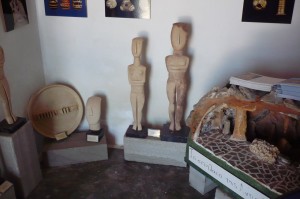

Antiparos (Greek: Αντίπαρος; Ancient Greek: Ὠλίαρος Oliaros) is a small island in the southern Aegean, at the heart of the Cyclades, which is less than one nautical mile (1.9 km) from Paros, the port to which it is connected with a local ferry. Saliagos island is the most ancient settlement in the Cyclades, and Despotiko, an uninhabited island in the southwest of Antiparos, is a place of great archaeological importance.
Archaeology
There are extensive Neolithic remains on the island. The first excavations were those made by the traveller Theodore Bent in 1884, who opened up some 40 graves in two cemeteries. In 1889 Christos Tsountas excavated in Despotiko, revealing Cycladic cemeteries. From 1964-5 a Neolithic settlement was excavated on the island of Saliagos by Colin Renfrew and J D Evans for the British School at Athens. Stone foundations of buildings, obsidian arrowheads and pottery were found, together with a marble figurine known as the Fat lady of Saliagos.

Classical remains are concentrated on the island of Despotiko. The Isle of Antiparos was identified with ancient Prepesintho, according to the extant writings of Strabo and Pliny.
In 1959 Nikos Zafiropoulos began excavations at Zoumparia and Mantra, on the northeast coast, where they were architectural Doric temple from the ancient times, dating to 500 BC.
In 1997, the archaeologist Yiannos Kourayos began new excavations at Mantra, bringing to light some of the ancillary buildings of a sanctuary. The temple itself has not so far been discovered, though a number of architectural elements from an early Doric temple have been discovered built into later walls. The main finding so far have been an elongated building, consisting of five consecutive parallel rooms. In the southern room archaic materials of Eastern Aegean, Rhodian, Cypriot and Egyptian origin have been discovered.
Many marble sculptures were found, including two archaic kouros head, a naked male statue, part of the Archaic period perirrantiriou inscribed with the inscription “Marda anethiken”. Among the significant findings include the built-square marble altar dedicated to Hestia Isthmus of classical times and which is testimony to one of the deities worshiped in the Cyclades.
Source Wikipedia.